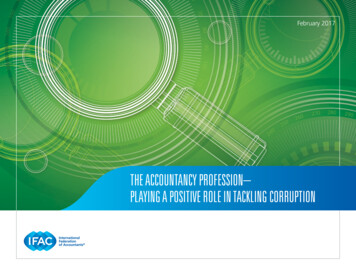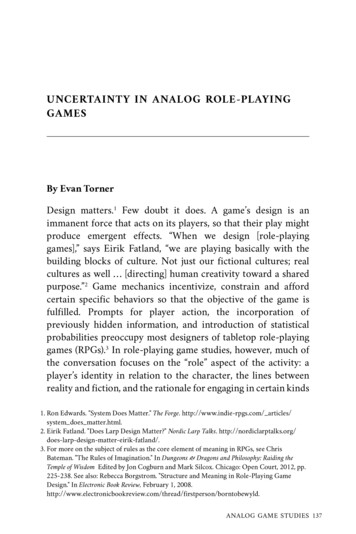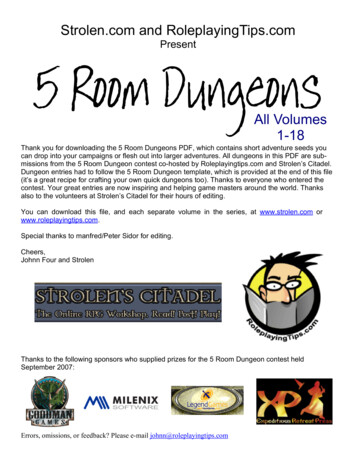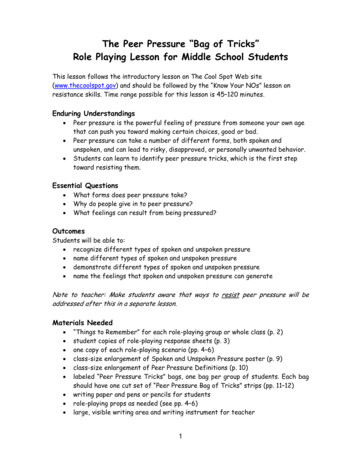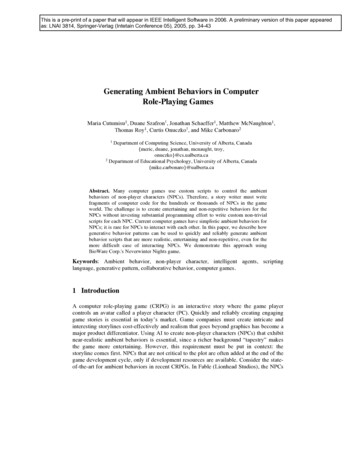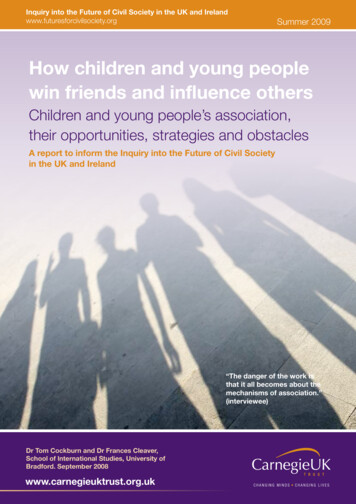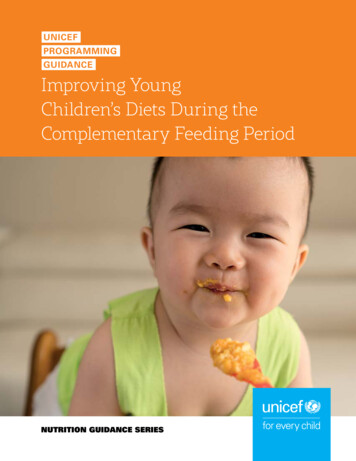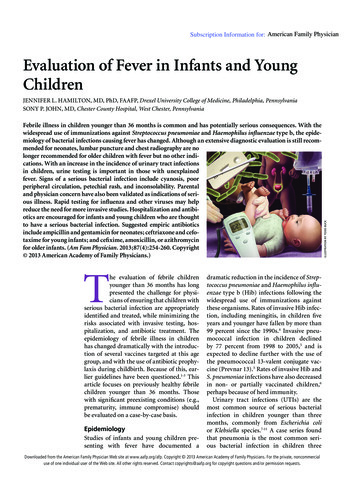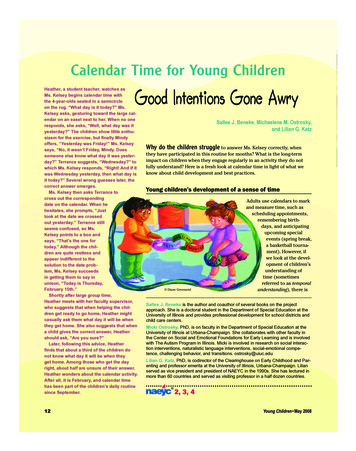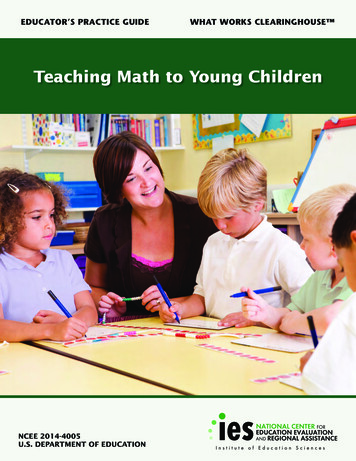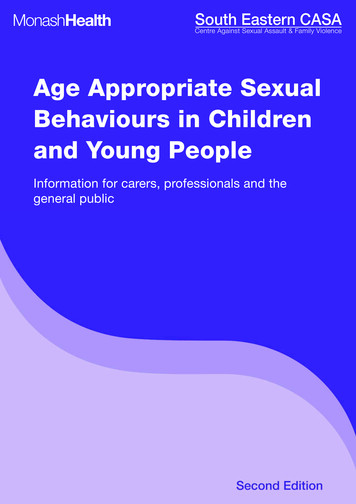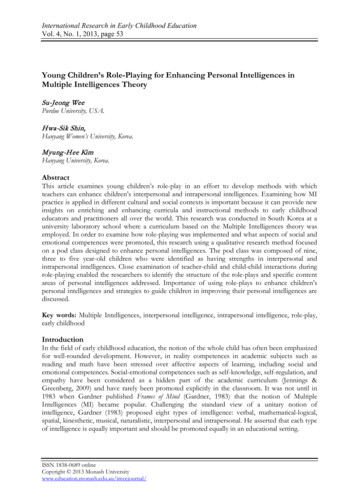
Transcription
International Research in Early Childhood EducationVol. 4, No. 1, 2013, page 53Young Children’s Role-Playing for Enhancing Personal Intelligences inMultiple Intelligences TheorySu-Jeong WeePurdue University, USA.Hwa-Sik Shin,Hanyang Women’s University, Korea.Myung-Hee KimHanyang University, Korea.AbstractThis article examines young children’s role-play in an effort to develop methods with whichteachers can enhance children’s interpersonal and intrapersonal intelligences. Examining how MIpractice is applied in different cultural and social contexts is important because it can provide newinsights on enriching and enhancing curricula and instructional methods to early childhoodeducators and practitioners all over the world. This research was conducted in South Korea at auniversity laboratory school where a curriculum based on the Multiple Intelligences theory wasemployed. In order to examine how role-playing was implemented and what aspects of social andemotional competences were promoted, this research using a qualitative research method focusedon a pod class designed to enhance personal intelligences. The pod class was composed of nine,three to five year-old children who were identified as having strengths in interpersonal andintrapersonal intelligences. Close examination of teacher-child and child-child interactions duringrole-playing enabled the researchers to identify the structure of the role-plays and specific contentareas of personal intelligences addressed. Importance of using role-plays to enhance children’spersonal intelligences and strategies to guide children in improving their personal intelligences arediscussed.Key words: Multiple Intelligences, interpersonal intelligence, intrapersonal intelligence, role-play,early childhoodIntroductionIn the field of early childhood education, the notion of the whole child has often been emphasizedfor well-rounded development. However, in reality competences in academic subjects such asreading and math have been stressed over affective aspects of learning, including social andemotional competences. Social-emotional competences such as self-knowledge, self-regulation, andempathy have been considered as a hidden part of the academic curriculum (Jennings &Greenberg, 2009) and have rarely been promoted explicitly in the classroom. It was not until in1983 when Gardner published Frames of Mind (Gardner, 1983) that the notion of MultipleIntelligences (MI) became popular. Challenging the standard view of a unitary notion ofintelligence, Gardner (1983) proposed eight types of intelligence: verbal, mathematical-logical,spatial, kinesthetic, musical, naturalistic, interpersonal and intrapersonal. He asserted that each typeof intelligence is equally important and should be promoted equally in an educational setting.ISSN 1838-0689 onlineCopyright 2013 Monash /
International Research in Early Childhood EducationVol. 4, No. 1, 2013, page 54Multiple Intelligences challenged the traditional notion of intelligence. While the traditional notionof intelligence views that people are born with a fixed amount of intelligence, MI considers that allindividuals possess each of the intelligences to some extent but with different degrees andcombinations of skills (Gardner, 1983). Traditional IQ tests, such as Stanford-Binet test andWechsler intelligence scale for children are not used in MI because these tests lack the ability tomeasure disciplinary mastery or deep understanding. Although MI theory has been criticized dueto the lack of empirical confirmation and strong stance on belief of intelligence as a unitary trait(White, 2004; Willingham, 2004), the notion of MI has been a great appeal to educators, especiallyearly childhood educators, who are concerned with the whole child. Many scholars believe that MIholds the power and potential for teachers to develop broad and flexible approaches to addressdiverse learners with differing skill sets or potentials (McFarlane, 2011).An important outcome of Gardner’s theory of MI to education has been curriculum efforts tryingto capitalize on individual child’s strengths (Armstrong, 2009). A growing number of educatorshave been paying attention to the environment where children’s intelligences are developed. As aresult, numerous countries all over the world have tried to apply MI theory according to theirunique social and educational contexts and have created their own contextualized version of thepractice (Chen, Moran, & Gardner, 2009). For instance, in the United States, Project Spectrum,designed to assess and identify distinctive areas of strengths of each child as an alternativeapproach to curriculum assessment and development, was initiated and implemented at TuftsUniversity (Krechevsky, 1998). More recently, educators in South Korea have created KoreanProject Spectrum (Shin & Kim, 2006; Yang, Shin, Lee, Hwang & Kim, 2004) in an effort todevelop their own version of Project Spectrum. Examining how MI theory is applied andimplemented in different cultural and social contexts can provide new insights on enriching andenhancing curricula and instructional methods, which can be beneficial for early childhoodeducators and practitioners all over the world. This research takes a close look at a unique MItheory-based curriculum for three to five year-old children implemented at a university laboratoryschool in South Korea.Among eight types of intelligence that Gardner proposed, interpersonal and intrapersonalintelligences are particularly important for young children to build because early childhood periodis a critical stage of developing social and emotional abilities (Sylva, 1997). Many scholars haveconfirmed a positive correlation between emotional competences and success in life (Welsh, Parke,Widaman, & O'Neil, 2001). Intrapersonal intelligence refers to self-knowledge and the ability to actadaptively on the basis of that knowledge. This intelligence includes having an accurate picture ofone’s strengths and limitations; awareness of inner moods, intentions, motivations, and desires;and the capacity for self-discipline, self-understanding, and self-esteem (Gardner & Hatch, 1989).Interpersonal intelligence refers to the ability to perceive and make distinctions in the moods,intentions, motivations, and feelings of other people. Gardner calls these two intelligences togetheras “personal intelligences” and highlights their connectivity: “I have always felt that the personalintelligences are most closely related to one another than any other two sets of intelligences(Boggeman, Hoerr, & Wallach, 1996, p. 36).” Knowing and understanding one’s self enables oneto better understand and relate to other people (Asendorpf & Aken, 1994; Denham et al., 2003;Henniger, 2009) exemplifying a positive correlation between interpersonal and intrapersonalintelligences. Because of this important interrelation, this research considers these two intelligencestogether as personal intelligences.ISSN 1838-0689 onlineCopyright 2013 Monash /
International Research in Early Childhood EducationVol. 4, No. 1, 2013, page 55Role-playing is considered as one of the best methods to help enhance children’s cognitive, social,and emotional competences (Blatner, 1995). Defined as “shared pretend play between children inwhich they temporarily act out the part of someone else using pretend actions and utterances”(Harris, 2000, p. 30), a role-play begins with the teacher introducing the problem, selecting theplayers, setting the stage, preparing the observers, presenting the enactment, and finally discussingand evaluating the play with the entire class (Shaftel & Shaftel, 1967). Previous studies have shownthat role-play enhances children’s languages learning (Grant & Mistry, 2010; Liu & Ding, 2009),communication skills (Veraksa, 2011), and understanding of the attitude of a specific subject area,such as science, math, and history (Cakici & Bayir, 2012; Deaton & Cook, 2012; Williams, 2010;Yonamine, 2010) as a cognitive domain. Furthermore, role-playing promotes skills of interpersonalproblem solving, self-awareness, understanding others’ feelings, expressing their own feelings,being empathetic to others, and controlling their emotions (Kitson, 1997; Rogers & Evans, 2006;Tyce, 2002; Wood & Attfield, 1996) as a social and emotional competence. By bringing real lifesituations into the classroom, children are given the opportunity to step into and examine asituation and take part in a sequence of events, thereby gaining an understanding of the reality theymay face outside the classroom (Vygotsky, 1978). Children can represent and act out their ideasand feelings in a safe environment and live through someone else’s experience, which in turn helpsthem develop empathy (Tyce, 2002; Weinert & Kluwe, 1987). Through this process, childrenintegrate emotion and thought. This integration proceeds from showing emotional and socialbehavior to increasing use of words and symbolic representation.By putting oneself in the place of another and understanding another’s role attributes, thoughts,and feelings (Mead,1934), role-play fosters decentering, which allows the ability to perceive,understand and consider simultaneously the varied or multiple aspects of objects, events andsituations (Fenson & Ramsay, 1980). These skills promoted through role-play are the corecomponents of Gardner’s interpersonal and intrapersonal intelligences. Furthermore, personalintelligences can be enhanced through various teaching strategies, such as group discussion, groupprocess, small group tasks, and reflecting (Campbell, 1997; Gardner, 1991, 2000), which are allessential parts of role-playing. Prior theoretical and empirical data provide support for exploringthe connection between role-play and young children’s personal intelligences. While there havebeen studies examining application of MI to various areas, such as foreign language learning (Glick,Armstrong, & Marchese, 2010; Savas, 2012), creativity (Clarke & Cripps, 2012), and arts learning(Barry, 2012; Valenti, 2012), only limited empirical research exists on role-play and youngchildren’s personal intelligences. Therefore, this research examines teaching approaches andcontents of role-plays in order to elucidate the relationship between role-plays and personalintelligences.MethodsSettingThis research took place at the laboratory school of H University located in Seoul, South Korea.The educational philosophy of H school was to support individual children’s potential to become aholistic human being and to enable them to contribute to creating future societal values. H schoolhad applied the MI theory to its practice for young children since 2003 in order to diversifychildren’s intelligence areas, fortify their areas of strength, and supplement weak ones. H schoolhad six classrooms in total (two classrooms of each three, four and five year olds) and eachclassroom had one head teacher and one assistant teacher.Pod ClassISSN 1838-0689 onlineCopyright 2013 Monash /
International Research in Early Childhood EducationVol. 4, No. 1, 2013, page 56H school implemented pod classes, which were special learning groups that students individuallyselected based upon their interests. Pods offered students opportunities to explore and experimenttheir strengths and interests in depth by working together with the teachers and other children,aiming to help children internalize their strength and succeed in their daily lives (Armstrong, 2009).In addition to the regular early childhood curriculum, H school ran seven pod classes in /intrapersonal, and spatial intelligence pods. According to his or her strengths andinterests, each child participated in a pod class once a week, every Friday, for an hour from 3:30 to4:30 pm. This research focused only on interpersonal/intrapersonal pod classes. Topics andsituations, which children may have difficulties or problems in, were discussed and selected forrole-plays by the pod class teachers in advance.For personal intelligence pod classes, the researchers developed a total of nine role-play activitieswhere the topics were chosen based on input from the teachers about the children’s experiencesand interests. Table 1 below shows a series of role-play activities for promoting children’s personalintelligences.Table 1: Title, Purpose and Content of Role-Play ActivitiesTitleMy gs ofothers’ and my own.Think about how to makeothers happy.Understand friends’ mindsand react accordingly.I Like YouExpress my affection toothers appropriately.I Hate MyBabyBrotherUnderstand that a siblingis not the competitor forparental love, but the onewhom I need to care forand love.Praise my friends’ and myown strengths.Let’sPraiseTo MyFriendsThink about why I likesomeone and express myfeelings toward the friend.Hard-toKeepThink about and expresswhat kind of promise isISSN 1838-0689 onlineCopyright 2013 Monash /ContentOpen an imaginary shop where you can buy any mind.Draw or sculpt with play dough what kind of mind youbought. Share your work and talk about how you wantto use the mind you purchased.Discuss characters in the flannel board story and comeup with a solution of the problem faced by thecharacters. Discuss how you felt after participating inthis role play and share whether or not a similar eventhappened to you.Imagine a situation having occurred and try out asolution that they created. Discuss what you came upwith in the role play and share appropriate ways to showthe affection to your friends.Play a role of the Bear’s mom and dad. Write a letter tothe Bear. After the role-play, share the lessons you’velearned, and promise to yourself that you will love yourparents and siblings more.Praise and encourage your friends. Hide one of thechildren behind the flannel board and have the rest ofthe children give encouraging remarks to the child whohides. Share how it feels when you hear praises.Draw who you think those friends are, and talk to themabout why you like/dislike them. Discuss how it is liketo confess your honest feelings toward your friends, andthink about how you can get along with them.Draw and write what is the most difficult promise tokeep. Then share it with each other. Discuss your
International Research in Early Childhood EducationVol. 4, No. 1, 2013, page 57PromiseWhat IWant toBecomeFree Hughard to keep, and why it isimportant to keep thatpromise.Discuss what kinds of jobI’d like to have in futureand what are required todo for the job.Experience how lovingand consoling it is to hugeach other.feelings about this activity.Create a headband that reads “future me” and introducefuture self. Think about what kind of work your parentsdo and what kind of work you’d like to do in future anddiscuss with the class.Read the book “Free Hug” and do as the main characterdoes, hold a “Free Hug” banner and hug people on thestreet. Share how you felt when you hugged to people.ParticipantsParticipants of this research were nine three to five year-old children and two teachers. For thisstudy, purposeful sampling was used. In order to identify children’s strengths, the Korean ProjectSpectrum (KPS) and Multiple Intelligence Developmental Assessment Scales-My Young Children(MIDAS-MYC) were used.KPS originated from the Project Spectrum evaluation. It is a Korean evaluation tool for four andfive year old children based on the Multiple Intelligences theory, which was translated, revised anddeveloped by Kim, Shin, and Joo (2001). Among the seven intelligence areas and 22 activities oforiginal Project Spectrum (Krechevsky, 1999), seven intelligence areas and fifteen activities, whichwere considered possible to apply to Korean educational context, were adopted. Each of the sevenintelligence areas has its corresponding activity and evaluation rubric (Kim et al., 2006).Performance based evaluation rubrics assess children’s abilities by observing their play proceduresor analyzing their artworks. Table 2 describes KPS’s specific activities of each intelligence area.Table 2: Activities of each intelligence area in ArtMusicalActivities and subcategoriesCreative movement activities: popcorn, animal pretending, scarf dancing(sensitivity to rhythm, expressivity, physical control, creation of ideasabout movements, responsiveness to music)Storyboard (structure of story, consistency of story, use of storytellingvoice, use of conversation, use of tense, effective expression, vocabulary,sentence structure)Turtle board game (direction of movement, counting, selection of dice,selection of movement, selection of number dice)Ant hunting game (decoding, meaning of blue, verbal expression ofrules, appropriate move of sorting box)Classroom model (understanding of self, understanding of others,understanding of social role)Peer interaction checklist (evaluation of children’s position by peer group)Animal drawing, person drawing, imaginary animal drawing (level ofexpression, exploration, artistic level)Song singing (rhythm, melody)ISSN 1838-0689 onlineCopyright 2013 Monash /
International Research in Early Childhood EducationVol. 4, No. 1, 2013, page 58MIDAS-MYC (Yang, Shin, Lee, Hwang & Kim, 2004) revised and supplemented MIDAS, whichprovides an efficient method of obtaining a descriptive assessment of a child’s multiple intelligenceprofile. MIDAS is a self-report measure of intellectual disposition and may be completed by eitherthe child or the parent. MIDAS-MYC includes 94 items over eight intelligence areas (linguistic,logical-mathematical, intrapersonal, interpersonal, kinesthetic, musical, spatial, and naturalistic).The six-Likert scale is used: never, seldom, sometimes, often, frequently, and all the time.Questions evaluating interpersonal intelligences are thirteen items, including “does the child initiateplay among peers?” and “does the child understand other’s feelings?”Each child was identified by his/her strongest area and assigned to the corresponding pod class.For interpersonal and intrapersonal pod class, nine children whose strongest area was personalintelligences were selected. The participating children were two three-year-olds (one boy and onegirl), five four-year-olds (one boy and four girls), and two five-year-olds (two girls).Two personal intelligence pod teachers (Ms. H and Ms. K) participated in the research. Ms. Hreceived her Bachelor’s and Master’s degree in early childhood education and had been working atH school for five years. Ms. K’s Bachelor’s degree was in early childhood and this was her thirdyear at H school. These two teachers had been team-teaching role-play in personal pod classes forthree years and both had shown strength in these intelligence areas. They planned role-playactivities together guided by the researchers. Most of the times, Ms. H led role-plays with thechildren in the pod class while Ms. K provided the materials and videotaped the activities.Data CollectionQualitative research methods were used for this research to explore how role-plays wereimplemented to enhance young children’s personal intelligences and what specific competenceswere promoted through role-plays. Data were collected through participatory observations, indepth interviews with the participants, and analysis of relevant documents.All role-play activities in the pod class were observed once a week for five months. Field noteswere taken and all activities were videotaped and transcribed. Formal 30-minute interviews withMs. H and Ms. K, once each, were conducted focusing on the teacher’s op
emotional competences were promoted, this research using a qualitative research method focused on a pod class designed to enhance personal intelligences. The pod class was composed of nine, three to five year-old children who were identified as having st
